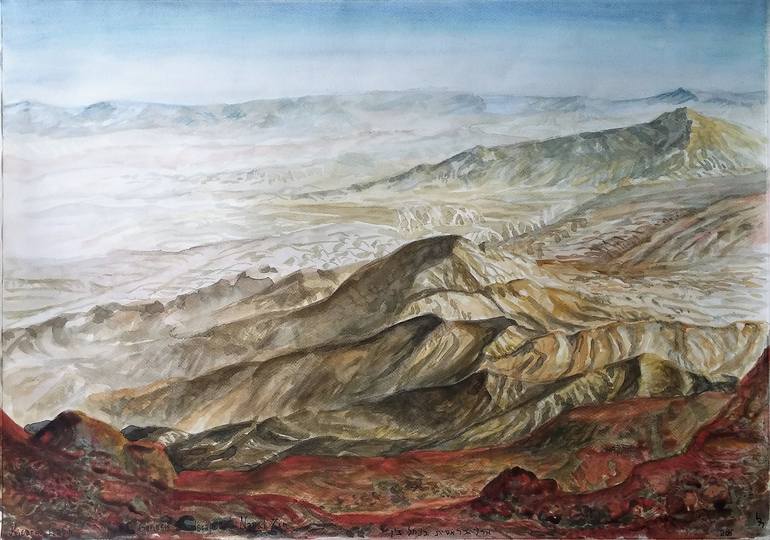







VIEW IN MY ROOM
Genesis Landscape at Nahal Zin Painting
Israel
Painting, Ink on Paper
Size: 27.6 W x 19.7 H x 0 D in
Ships in a Tube
About The Artwork
Deserts (and islands too) attract me like a magnet. I can deeply understand why the monks at Holy Land went to isolated caves for meditation: the landscape is paradoxically empty and full of elements, of life. Each stone changes shape & color when the sun changes angles each couple of hours, and became a symphony of lights and shadows, with wind and dust glazing the view constantly. This place is called today Nahal Zin ( something like Zin River, but if river only when few days of rain arrive here), and by the local Bedouins "Wadi El-Fikra". When it rains, the water of the high areas goes down to these channels, in a flood of water, stones and mud, destroying everything in its path. It is an imposing and terrifying spectacle of the forces of Nature. Exist in this area the legend of a mythical river called Sambation, who during six days is impossible to cross, but it stops flowing every Saturday. It's a Cabalistic Legend, but based in Roman data: Pliny the Elder, writing in the mid-1st century, mentions that there is a river in Judaea that dries up every Shabbat (NH xxxi.18). His younger contemporary Josephus speaks of the Sabbatical River (Σαββατικον) that he claims was called after "the sacred seventh day of the Jews" and that he locates between Arka (in the northern Lebanon range) and Raphanaea (in Upper Syria) (War 7.96-99), although according to his account it is dry for six days and flows only on Shabbat. Till here the legends. Painting the environment is a type of deep meditation, of observing each fold of the ground, its nuances, its shadows. As Monet observed, the same place is constantly in change, and at places like the deserts, of extrem conditions for Life, forms and contents are filled with energy. A great challenge to paint this places.
Details & Dimensions
Painting:Ink on Paper
Original:One-of-a-kind Artwork
Size:27.6 W x 19.7 H x 0 D in
Frame:Not Framed
Ready to Hang:Not applicable
Packaging:Ships Rolled in a Tube
Shipping & Returns
Delivery Time:Typically 5-7 business days for domestic shipments, 10-14 business days for international shipments.
Handling:Ships rolled in a tube. Artists are responsible for packaging and adhering to Saatchi Art’s packaging guidelines.
Ships From:Israel.
Have additional questions?
Please visit our help section or contact us.
Israel
Ricardo Lapin is a plastic artist based in Israel. He was born at Buenos Aires, Argentina, 1961. At age 16 he left to Israel at the times of Military "Junta". He began to study oil painting at age 10, and this discipline become a way of life: with more knowledge & experience, it continues till today. My Artist Statement: Art is a meeting between the individual and the universal, question marks about the human soul. I believe that the artist must reflect the "Zeitgeist" of the period he works. My own struggles and dilemmas, the culture and environment in which I live are present in every piece of work. Painting for me is my inmost protected and stable place, like a priceless shelter. Always present, since my early childhood, despite changing situations and realities. A territory that can be built and changed endlessly, a meeting place for memories, fears, desires. Within the creative process everything has existence, without a name or definition, there is place where everything is possible and can be repaired. My work is born mainly from images, the imagery nurtured by experiences, stemming from memories and dreams, mine and from my family. The artist work examines and describes the existence of man in this world, allows the brave inquiring of actual and local values . Alongside the aesthetic expression, my works seek to examine the limits of justice and freedom, the meaning of life and death in a period of spiritual loss, depression and continuing devaluation of human lives. Images come to me. As waking up from a dream, I catch them by sketching, drawing them before they escape; after that I articulate them and find new related images, in an associative process. I can perceive that many images have an aroma of oral stories, memories, family legends, secret traumas. Sometimes they arrive from mystery and remain there, even when already painted. The final work is sometimes a kind of unfinished sentence, to be filled in by the public, in many surprising ways, sometimes very far from my associations & ideas during the creative process. It's always magic and truthful for me to realize about the multiple ways of reading my work.
Thousands Of Five-Star Reviews
We deliver world-class customer service to all of our art buyers.
Global Selection
Explore an unparalleled artwork selection by artists from around the world.
Satisfaction Guaranteed
Our 14-day satisfaction guarantee allows you to buy with confidence.
Support An Artist With Every Purchase
We pay our artists more on every sale than other galleries.
Need More Help?